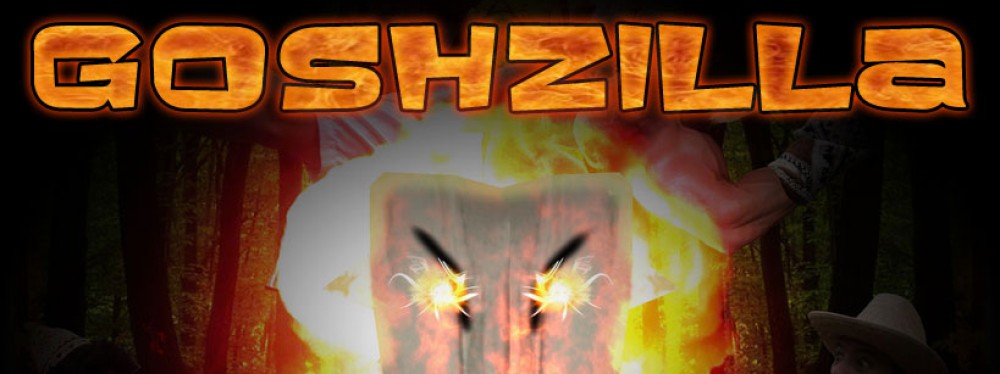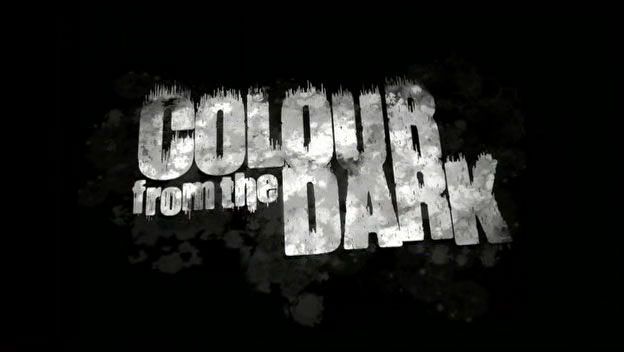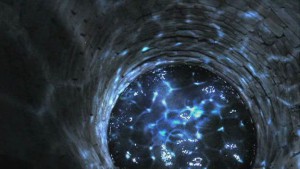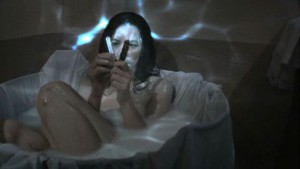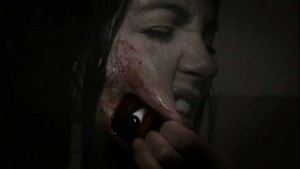I’m not as big into H.P. Lovecraft as many others, and in actuality I didn’t even know who he was until recently. It was more of a concept that I didn’t get for a long time. That said, it appeared that the many adaptations of his work would vary to a wide degree. After realizing that the subject matter originated in literature and your mind was meant to fill in the lack of details, there is also the fact that no one can really see many of these creatures since they are unimaginable horrors or simply make you go mad.
Releases like the Dunwich Horror, which I couldn’t bring myself to finish, were dreadfully dull and seemed to deal with futurist occult material. The Unnameable series and Castle Freak became traditional monster movies, while Dreams in a Witchhouse treads some more psychological yet still tangible ground. [break]
As far as I’ve seen, Colour from the Dark comes the closest to portraying an entity that is never described, nor directly referenced, yet still provides the effects of its presence through the misfortunes of those who cross paths. In this way, it proves to be more effective and something that is normally difficult to portray in a medium that relies heavily on visuals. But by seeing the outcomes, we are left to guess what the source truly is.
We’re introduced to primarily a cast of three. The movie is wise in a few aspects in regards to how the environment is set up. For one, the list of characters remain very small. Aside from the main three, there are only a few supporting characters and their screen time is brief. Second the actors/actresses are convincingly adults. Much like the days of 70’s Eurotrash, no matter how bad the movie was, they at least attempted to dress it up without resorting to some people in their 30’s acting like they’re in their 20’s while pretending they’re back in their 30’s. Read my other reviews and you’ll see this recurring theme.
Now a brief look into the careers of the actresses will show a few common themes. One being frequent participants in the skinemax genre, but also that they are veterans of the b-movie circuit in general. If you’ve watched enough low budget movies in your time, you’ll be sure to run across Debbie Rochon. Not only from sheer volume, but also due to the timeline of productions she’s been involved with. Some like Maria Ford and Julie Strain might be other candidates, but a quick look at their filmography shows that while a few projects pop up from time to time, they can’t touch Debbie’s juggernaut approach to film. I mean she has over twenty movies currently in various stages of production, and pushing 10 times that overall. Additionally few have been able to rise past the exploitative aspects of their career and gather some decent roles (by our standard), with the exception of Jacqueline Lovell, but usually the decision spells career nosedive.
The setting for the story also adds some interest. It takes place in a very rural Italian village in 1943. At this time the omnipresent German forces were a constant strain on normal civilian life, and while this is not directly addressed, it is alluded to during brief moments throughout the film. This setting helps in that it allows for a very ancient feel, both in the housing structures and way of life. I’m a fan of the European rural decay feel, and here it is perfected.
Overall there is a feeling of some outside entity that is greater, more powerful and generally mysterious. It tampers with their simple existence. Much like the Nazi presence, and it may explain the only brief occurrences of any soldiers, the entity appears to be an abstract analogy. After its discovery by the viewer in the local well, initially miraculous events happen. At first the water from the well grows enormous vegetables when used to water the garden. The husband’s constant limp is healed after drinking the water, and the autistic sister who lives with them, begins to communicate and finally talk. However much like the Communist regime that promises to provide everything, the drawbacks are often much worse. The power that provides will ultimately corrupt.
The entity also appears to be overtly anti-religious. Christian iconography is defamed by the being, and an attempted exorcism first confuses the priest with a graphic and realistic vision of death simply to torment him before it actually follows through. While there is a fair amount of actual violence perpetrated by the entity, psychological means are often employed beforehand to break people down. It’s often through visions of self mutilation, confusion, and possession which in turn affects others. While the husband and wife are strained from the sudden personality change, the sister suddenly takes an interest in him, which further causes the breakdown of the household.
While direct contact with the entity-tainted water provides the most potent effects, others are not spared by the indirect actions of those possessed. In the end, there are few who are spared from something as unassuming as a well.
Now I can’t say this is the greatest movie ever, as that’s a tall order, but it’s nice to see something that’s competent and put together well. If we could have a few more of these and less college-aged movies, I’d be very happy.
